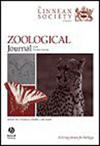Shining disco: shedding light into the systematics of the family Discodorididae (Gastropoda: Nudibranchia)
IF 2.8
2区 生物学
Q1 ZOOLOGY
引用次数: 0
Abstract
The evolutionary relationships among genera within the nudibranch family Discodorididae remain poorly understood, with comprehensive molecular studies still largely absent. Discodoris, the most species-rich genus within this family, has historically represented a wastebasket taxon where species with ‘discodoridid’ morphology were placed. In this study, we present molecular data to evaluate the taxonomic classification of the family and to investigate potential (pseudo)cryptic diversity. Our molecular analyses comprised a multilocus phylogenetic analysis of 199 specimens, including 20 type species. The dataset included 142 specimens belonging to Discodorididae, 24 from Dorididae, and 33 outgroup taxa. A total of 52 specimens from 30 different species of Discodorididae, including six type taxa, were sequenced from the Mediterranean Sea, Eastern Atlantic Ocean, and Central and South America. Phylogenetic analyses recovered the monophyly of the family Discodorididae but including the doridid Aphelodoris, revealing evidence of hidden diversity in several genera such as Taringa, Tayuva, Paradoris, and Geitodoris. Our study unveiled the paraphyly of the genera Discodoris and Diaulula, which warrant a critical appraisal of their morphology. Overall, we provide relevant molecular information to infer the most complete phylogeny of Discodorididae to date and identify new questions for future studies.闪亮的迪斯科:揭示迪斯科科的系统分类(腹足目:裸鳃亚目)
裸鳃科Discodorididae属之间的进化关系仍然知之甚少,全面的分子研究仍然很大程度上缺乏。作为该科中物种最丰富的属,Discodoris在历史上代表了一个“废纸篓”分类群,其中具有“discodoridid”形态的物种被放置在那里。在这项研究中,我们提供分子数据来评估该家族的分类分类,并调查潜在的(伪)隐多样性。我们的分子分析包括199个标本的多位点系统发育分析,其中包括20个模式种。数据集包括142个飞蛾科标本,24个飞蛾科标本,33个外群分类群。对来自地中海、东大西洋和中南美洲的盘虫科6个类型分类群、30种52个标本进行了测序。系统发育分析恢复了Discodorididae家族的单一性,但包括doridid Aphelodoris,揭示了Taringa, Tayuva, Paradoris和Geitodoris等几个属的隐藏多样性证据。我们的研究揭示了部分属的Discodoris和Diaulula,这保证了一个关键的评估他们的形态。总的来说,我们提供了相关的分子信息来推断迄今为止最完整的Discodorididae系统发育,并为未来的研究确定了新的问题。
本文章由计算机程序翻译,如有差异,请以英文原文为准。
求助全文
约1分钟内获得全文
求助全文
来源期刊
CiteScore
6.50
自引率
10.70%
发文量
116
审稿时长
6-12 weeks
期刊介绍:
The Zoological Journal of the Linnean Society publishes papers on systematic and evolutionary zoology and comparative, functional and other studies where relevant to these areas. Studies of extinct as well as living animals are included. Reviews are also published; these may be invited by the Editorial Board, but uninvited reviews may also be considered. The Zoological Journal also has a wide circulation amongst zoologists and although narrowly specialized papers are not excluded, potential authors should bear that readership in mind.

 求助内容:
求助内容: 应助结果提醒方式:
应助结果提醒方式:


